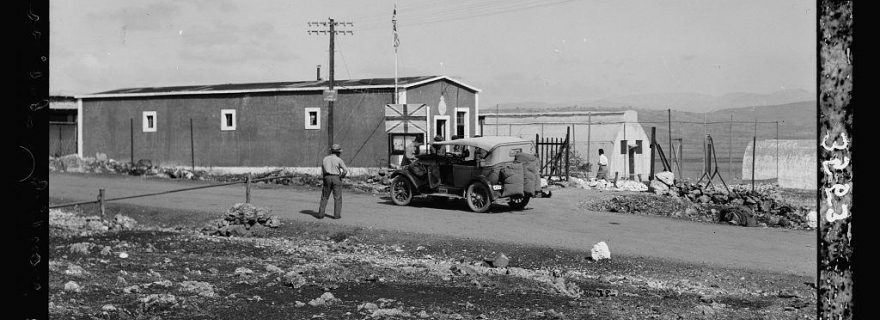Partitioning the Middle East: The Palestine-Lebanon Border in the Mandates period
The borders created by the colonial powers in the Middle East were not only lines drawn on a map, but also a physical and juridical reality. In this blog, Mattia Serra discusses the local consequences of the imposition of the Palestine-Lebanon border in the Mandates period.
The partition of the Ottoman Empire is a recurring topic in the scholarship on the Middle East. Scholars from different disciplines have discussed extensively the Sykes-Picot Agreement, the Balfour Declaration, and the Anglo-French negotiations that brought the region to its current shape. However, this large body of literature has mainly focused on political and military developments, often overlooking the material and juridical dimensions of these borders. Adopting a micro-level approach, this piece addresses the local consequences of the imposition of the border between Palestine and Lebanon in the Mandates period.
Similarly to other boundaries in the region, the border between Mandate Palestine and Lebanon did not correspond to any of the jurisdictional lines previously employed by the Ottomans. It passed through an extremely heterogeneous region, inhabited by Sunnis, Shi’is, Druzes, and Christians from different confessions. With few exceptions, the delimitation process was generally accurate in including Shi’i villages within Lebanon and Jewish settlements within Palestine. However, the border did not follow local land ownership, and in many cases, it divided certain towns from their natural hinterlands. Overall, the establishment of the boundary affected the upper Galilee in at least three ways: through the regulation of cross-border mobility, intensified state control, and the growth of smuggling networks.
First of all, the border brought bureaucratic and infrastructural changes to the region. Circulation across the border was canalized through the institution of border posts and the construction of roads, bridges, and highways. Local mobility was regulated in 1926 through a Bon Voisinage Agreement and the creation of a border-pass system. On a juridical level, peasants enjoyed farming and grazing rights on their land, regardless of the side on which it was situated. However, these rights could be suspended in periods of political unrest or due to sanitary concerns, ultimately forcing many peasants to sell their possessions on the other side. Throughout the Mandates period, the borderland continued to function as a single economic unit, but the presence of the border decisively favoured certain towns over others.
Secondly, the creation of the border intensified state control over this peripheral area. Border guards, policemen, and soldiers became a permanent presence in this region, and although their number was normally kept to a minimum, it was raised significantly in periods of unrest like the 1925-26 Syrian Revolt and the 1929 Palestine riots. During the 1936-39 Revolt, the borderland assumed a decisive strategic role. In the summer of 1938, in an attempt to gain stricter control of northern Palestine, the British built a security fence along the border. Although efficient in its purpose, the fence prompted a strong reaction from the local peasantry, who on both sides started to organize sabotage operations against it. Challenged by the economic burden of the fence’s continuous reconstruction, the British decided to militarize the border area, ultimately succeeding in their intention of cutting off the rebels from their supply and information routes.
Finally, the creation of the border connected southern Lebanon and northern Palestine with regional smuggling networks. Border villages became transit points where smugglers could store goods and organize their shipments. Ranging from small flows of legal commodities to the more organized smuggling of weapons and narcotics, these networks facilitated the rise of a local class of traffickers and rogues. In the war years, the borderland developed an integrated black market for rationed goods, which soon intersected with pre-existing illegal flows. Challenged by the growth of these networks, the British were forced to strengthen their presence in the borderland, aggravating the already precarious situation of the local peasantry.
The relation the local population had with the border was complex and multiform. From a bureaucratic point of view, the local peasantry complied to a large extent with the border regulations. The policemen and customs agents stationed at the border often acted arbitrarily, and the lack of proper documents could result in customs seizure, detention and physical violence. The partition was a cogent reality, and as early as 1921, French officers remarked to their utmost surprise that the Palestinian population was showing an “irregular determination” in its respect of the borderline. Despite this general compliance, state presence in the borderland was neither resisted nor simply accepted: it was negotiated. While many local peasants and notables engaged with contraband, many others provided colonial authorities with information on the movement of strangers and smugglers across the border. In the war years, peasant petitions in the Jabal ‘Amil often called for the intensification of the fight against food smuggling and price inflation. Further, state control over the border could become a topic of national debate. For instance, in 1934, a political campaign against Jewish illegal immigration ultimately compelled the British to increase the number of policemen stationed in the borderland.
Borders are inherently intrusive entities. For a long time, scholars of the Middle East have underestimated their material and juridical significance, focusing instead on diplomatic and military outcomes. As this piece shows, a micro approach enables us to study the indigenous response to these colonial impositions in its complexity. Besides being lines drawn on a map, these borders are a physical reality that continues to influence the lives of those crossing them.



1 Comment
thank you
very informative article
please wrote more about Ottoman Empire
salam,
ahmad
"kajian agama islam"
https://www.youtube.com/watch?v=5FsG5gB8GLo&t=14s
https://www.youtube.com/watch?v=_x4cSz6Gifo&t=68s